For patients concerned about veneer stain, it’s important to understand that dental veneers are far more resistant to discoloration than natural teeth, but they are not completely immune to staining. Many people ask, “can you stain veneer?” The answer is that although veneers (especially porcelain ones) are designed to resist stains, they can still gradually accumulate discoloration over the years when exposed to the same things that stain natural teeth.
Regularly drinking pigmented beverages like coffee, tea, or red wine and eating deeply colored foods such as berries or tomato sauce can eventually dull a veneer’s bright surface. Likewise, smoking introduces nicotine and tar that can yellow veneers over time. Additionally, poor oral hygiene allows plaque and tartar to build up on veneers, creating a rough surface that traps stains, and normal aging plus everyday wear can make the veneer’s protective glaze slightly more porous, allowing more discoloration to seep in over the years.
The good news is that patients can manage or prevent most veneer stains by taking proper care of their veneers. Dentists advise quitting smoking and moderating intake of stain-causing drinks and foods, practicing excellent oral hygiene (gentle brushing with a soft-bristled toothbrush and daily flossing), and attending regular dental cleanings and checkups to keep veneers looking their best. By understanding the causes of veneer staining and following these preventive measures, international dental patients considering veneers can enjoy a long-lasting, radiant smile with minimal discolouration.
Dental veneers are thin layers of porcelain that are bonded to the front of the teeth to boost their look and function. The custom-designed, wafer-thin shells are formed from porcelain or resin composite and smoothly cover the fronts of teeth, orchestrating symphonies of perfection in smiles. “Do veneers stain?” “Do porcelain veneers stain?” “Can you stain veneer?” “Can veneers be removed?” These queries echo a common concern, the spectre of staining. Take a look at veneer staining's causes, culprits, and prevention methods in “Veneer Stains: Causes & Prevention”.
Veneers are dental fillings that are bonded permanently to the top layer of teeth to boost their look. They’re commonly created with porcelain or resin composite materials, both of which mimic the natural colour and texture of teeth. Veneers correct a range of issues, including chipping, misalignment, discolouration, and spaces in between teeth. Their versatility and realistic appearance have made them a sought-after choice for achieving a picture-perfect smile.
Veneers are much more stain-resistant than natural teeth, but they become discoloured over time. The causes of veneer stains are similar to those of natural tooth stains. Some common factors include consuming pigmented foods and beverages, smoking, poor oral hygiene, ageing, and wear and tear.
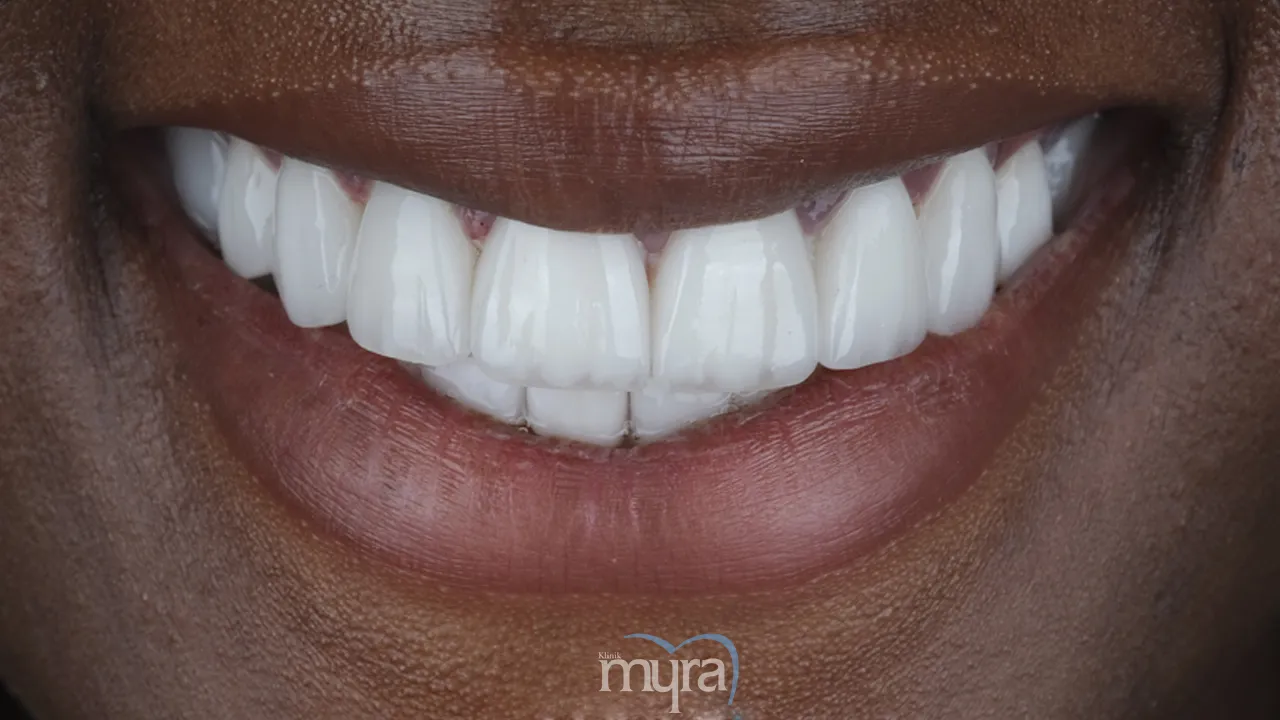 Consuming foods and drinks with intense colour pigments, such as coffee, tea, red wine, and dark berries, contributes to veneer stains over time. Smoking or using other tobacco products leads to persistent staining of veneers due to the nicotine and tar content. Inadequate oral hygiene practises lead to the buildup of plaque and tartar on veneer surfaces, promoting stain retention. Veneers become more porous, making them slightly more susceptible to staining as they age. The outer layer of veneers experiences minor wear over time, potentially exposing the underlying material to staining agents.
Consuming foods and drinks with intense colour pigments, such as coffee, tea, red wine, and dark berries, contributes to veneer stains over time. Smoking or using other tobacco products leads to persistent staining of veneers due to the nicotine and tar content. Inadequate oral hygiene practises lead to the buildup of plaque and tartar on veneer surfaces, promoting stain retention. Veneers become more porous, making them slightly more susceptible to staining as they age. The outer layer of veneers experiences minor wear over time, potentially exposing the underlying material to staining agents.
Certain foods are bad for veneers and cause them to stain, such as coffee and tea, red wine, berries, sauces, and dark-coloured beverages. Coffee and tea beverages contain tannins and pigments that adhere to veneer surfaces. The deep colour and acidity of red wine contribute to veneer discolouration. Blueberries, blackberries, and other deeply pigmented fruits stain veneers. Tomato-based sauces, such as pasta sauce and soy sauce, contain colourants that stain veneers. Colas and dark sodas discolour veneers due to their colour and acidity.
Veneers are relatively stain-resistant, and adopting preventive measures helps maintain their appearance over time. Avoiding staining of veneers involves quitting smoking, abstaining from staining foods, refraining from teeth grinding, using a soft toothbrush, and scheduling regular dental checkups.
Consider quitting smoking. Tobacco use stains veneers and poses risks to one’s oral health. Staining foods and drinks are difficult to avoid altogether, but one is able to lessen the effects on their veneers by limiting consumption and rinsing their mouth afterwards. Teeth grinding (bruxism) leads to premature wear and potential damage to the veneers. See a dentist about getting a nightguard or other treatment for bruxism to preserve the veneers. Use a soft-bristled toothbrush and a non-abrasive whitening toothpaste. Harsh toothbrushes and abrasive toothpaste scratch the surface of veneers, making them more susceptible to staining. Regular visits to the dentist are crucial for maintaining the health and appearance of the veneers. Professional cleanings get rid of stains on the surface and make sure that the veneers and teeth underneath stay in good shape.
What is Veneer?
Dental veneers, or "veneers," are ultra-thin shells crafted from tooth-coloured components such as porcelain or resin composite. The carefully crafted coverings are meant to fit over the front of the teeth, hiding any flaws and making a person's smile attractive. Veneers are capable of altering the shape, colour, size, and size of teeth by bonding them with dental adhesive. Thanks to their convincing resemblance to real teeth, dental veneers have quickly gained popularity as a method of concealing lots of aesthetic dental problems and restoring a uniform and lovely smile.
What causes veneers to stain?
The causes of veneer staining are listed below.
- Consuming Staining Foods and Drinks: Consuming meals and drinks that are known to stain teeth has the same effect on veneers as on natural teeth. Coffee, tea, red wine, dark berries, and deeply pigmented foods gradually lead to discolouration.
- Smoking or Using Tobacco Products: Tobacco use introduces nicotine and tar to the oral environment, both of which adhere to veneer surfaces and cause unsightly stains over time.
- Poor Oral Hygiene: Inadequate oral hygiene practises pave the way for plaque and tartar buildup on veneers, providing a rough surface for stains to latch onto.
- Natural Wear and Tear: The outer layer of veneers gets a little worn over time, making them slightly more porous. The increased porosity makes veneers more prone to picking up stains.
- Exposure to Pigmented Substances: The same process that stains natural teeth stains veneers when they come into contact with naturally occurring pigments. Including contact with materials that contain strong dyes or colourants, leading to gradual discolouration.
- Inadequate Care and Maintenance: The accumulation of stains on veneers results from neglecting proper oral hygiene practises, such as flossing, brushing, and professional dental cleanings.
1. Consuming foods and drinks that are known to stain teeth.
The habit of consuming meals and drinks with intense colour pigments causes discolouration of the dental veneers.
The cause of veneer staining lies in the porous nature of the materials used in veneers, such as porcelain or resin composite. The pigmented compounds adhere to and stain both natural teeth and veneers. Veneers' resistance to staining is higher compared to natural teeth. Their porous structure allows chromogens and tannins, found in products such as tea, coffee, red wine, and berries, to penetrate over time. The compounds become trapped within the veneer material, leading to a gradual alteration in the veneers' colour and diminishing their aesthetic appeal. Veneers are designed to improve tooth appearance, but they are prone to staining from meals and beverages.
2. Smoking or using tobacco products.
Smoking covers the act of inhaling or using tobacco-derived substances, including traditional smoking of cigarettes, cigars, or pipes, and the use of electronic cigarettes or smokeless tobacco products. The presence of nicotine, tar, and other pigmented compounds in these substances is primarily responsible for the staining that smoking, using e-cigarettes, or using tobacco products causes on veneers.
Tobacco products are addictive because of nicotine. It is highly pigmented and readily binds to dental surfaces, including veneers. Tar, a complex mixture of organic compounds formed during tobacco combustion, is another culprit with pigmented qualities. The compounds are released as aerosols or vapours when tobacco is smoked or used, and they come into contact with the surfaces of teeth and veneers. Veneers are porous, even though they are stain-resistant. Porcelain veneers are especially susceptible. The porous nature allows nicotine, tar, and other pigmented particles to permeate the veneer's microstructure over time. The gradual accumulation of pigments alters the veneer's original colour and appearance, leading to visible staining.
Electronic cigarettes contain nicotine and other compounds that contribute to staining. E-cigarettes discolour veneers due to the presence of pigmented substances in the vapour, despite being potentially less staining than conventional cigarettes.
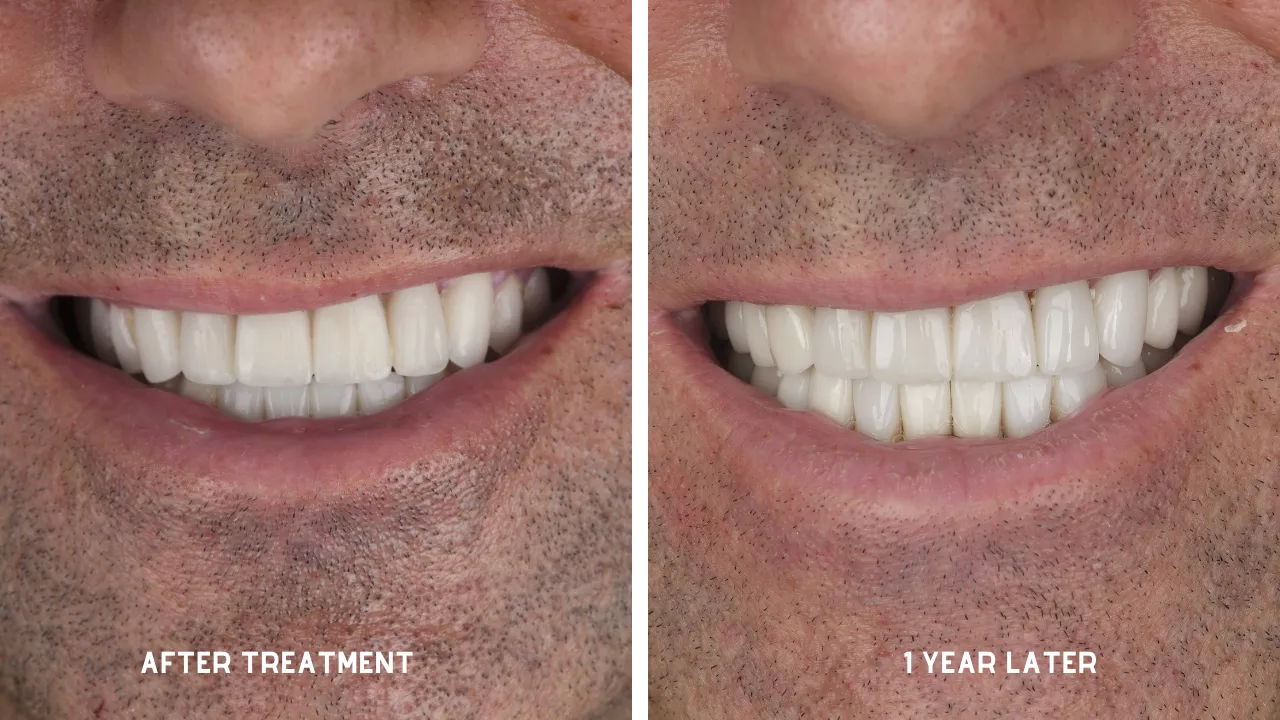
3. Poor oral hygiene causes plaque and tartar, which can stain.
Poor oral hygiene occurs when people don’t take care of their teeth well enough or don’t do it consistently enough. Including not brushing, flossing, or getting professional dental cleanings. The connection between poor oral hygiene, plaque, tartar, and veneer staining lies in the intricate interaction between dental hygiene practises and the accumulation of stain-causing substances.
Plaque is a biofilm that forms on teeth and veneers and is made up of bacteria, food debris, and saliva. Plaque traps food and drink stain pigments and discolour the veneer's surface if it is not removed by regular brushing and flossing. The porous nature of veneers, especially if they are made of materials such as porcelain, makes them a great place for these pigments to stick.
Plaque hardens into tartar over time if it is not removed properly. Tartar forms along the gumline and on the surfaces of teeth and veneers. Its rough texture provides an ideal surface for pigments to adhere to, further intensifying the potential for staining.
The reason poor oral hygiene contributes to veneer staining is twofold. The accumulation of plaque and tartar on veneers creates a roughened surface that harbours pigmented compounds from foods, drinks, and other environmental sources. The continued presence of these stain-causing substances leads to gradual discolouration, causing the veneer's appearance to change.
Proper oral hygiene practises, including regular brushing, flossing, and professional dental cleanings, are crucial in preventing the buildup of plaque and tartar on both natural teeth and veneers. Maintaining a clean and smooth surface lowers the likelihood of pigmented compounds adhering to veneers and causing staining.
4. Natural wear and tear makes veneers more porous and stainable.
Natural wear and tear refers to the gradual deterioration that occurs on the surface of veneers over time due to normal usage, biting, chewing, and exposure to various factors. The connection between natural wear and tear, increased porosity, and veneer staining hinges on the evolving structural changes that take place on the veneer's surface.
Veneers are meticulously designed for durability and resilience but are not immune to the effects of continuous use and exposure. The outer layer undergoes microscopic alterations that render it slightly more porous than when it was initially placed as veneers age. The increased porosity is a consequence of the normal wear and tear that occurs during biting, chewing, and other everyday activities.
Heightened porosity leads to veneer staining because of the veneer's altered ability to resist the penetration of staining agents. The increased porosity of the veneer makes it more susceptible to infiltration by pigmented compounds found in food, drink, and the environment. The pigments consequently embed themselves in the veneer material, which over time causes a gradual discoloration.
The phenomenon of natural wear and tear contributing to veneer staining underscores the importance of vigilant care and maintenance. Veneers withstand normal wear, but addressing staining agents and practising good oral hygiene reduce porosity and preserve their brilliance.
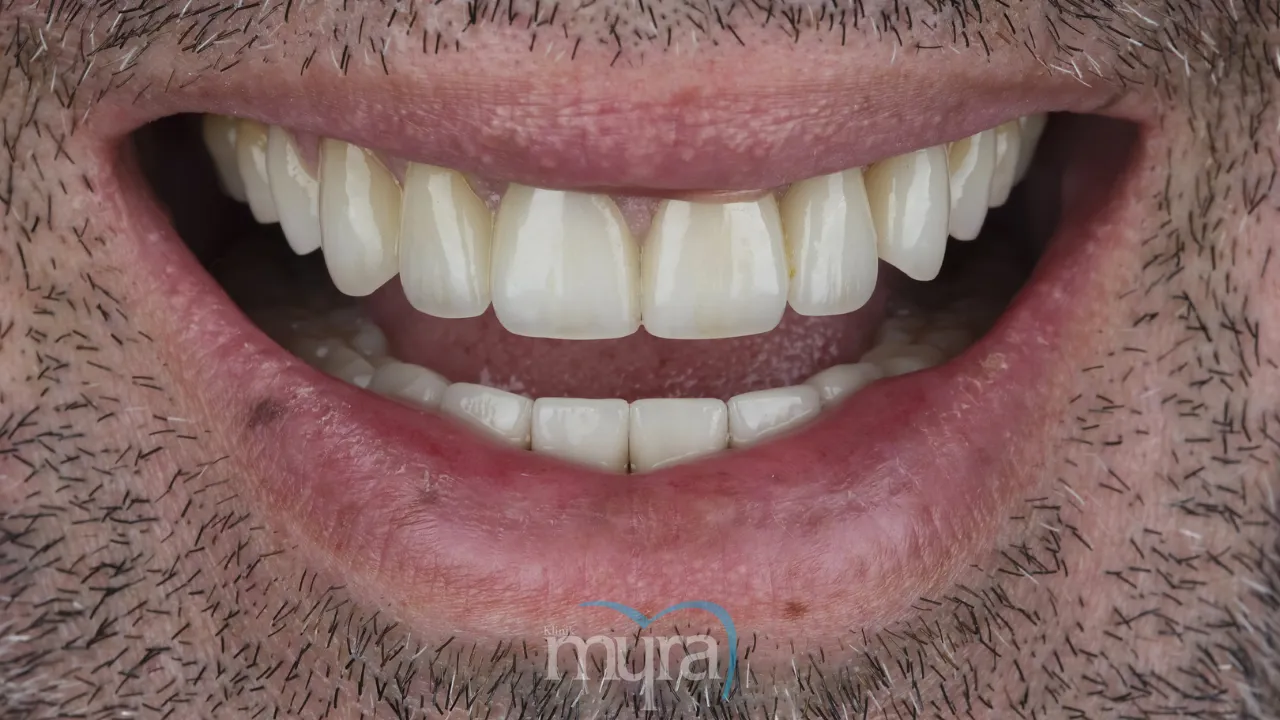
5. Exposure to certain pigmented substances in the environment.
Contact with materials or elements in the surrounding environment that contain vivid colourants or dyes leads to the staining of dental veneers. The reason exposure to pigmented substances in the environment causes veneer staining is rooted in the porous nature of veneer materials and their susceptibility to absorbing external colourants.
Veneers are carefully crafted for resilience and aesthetics, but their microstructure allows pigmented compounds from the environment to penetrate. The compounds originate from sources such as workplace chemicals, certain medications, or even household items.
The porous surface facilitates the absorption and retention of colourants when veneers come into contact with these pigmented substances. The veneer's microstructure becomes infused with these pigments over time, leading to gradual changes in colour and visible staining.
Veneers are made to last, but the way they react to environmental pigments is a constant reminder that they need care. Being aware of potential sources of pigmented substances in the environment and taking steps to limit exposure helps keep the veneer's original look. Regular oral hygiene practises, including flossing, brushing, and professional cleanings, play a critical role in combating the effects of environmental staining agents on veneers.

6. Inadequate care and maintenance of oral health and hygiene.
The reason for major staining on veneers is bad oral hygiene, which leads to stains. Inadequate cleaning and preservation of oral health and hygiene refer to neglecting regular dental hygiene practises, including brushing, flossing, and professional dental check-ups. The reason inadequate care and maintenance of oral health and hygiene lead to veneer staining lies in the progressive formation of stain-causing substances and compromised protective measures for veneers.
Veneers require consistent care to ensure their longevity and appearance. Veneers accumulate plaque due to poor oral hygiene. The plaque harbours pigments from foods, beverages, and other staining agents, gradually causing discolouration.
The absence of timely dental check-ups and professional cleanings leaves veneers vulnerable. Dental professionals use specialised tools to clear both surface stains and tartar formed on veneers, preserving their aesthetic appeal. Stains worsen when these routine visits are skipped, affecting the veneer's colour and brilliance.
Inadequate care and maintenance compromise the veneer's resistance to staining. Veneers lose their shine and become unsightly without regular plaque, tartar, and stain removal. Timely checkups and oral hygiene are essential to preventing veneer staining from poor care. Maintaining veneers' pristine appearance by cleaning and caring for veneers and natural teeth.
What are the foods that can cause veneers to stain?
The foods that cause veneers to stain are listed below.
- Coffee: Coffee's deep pigmentation and tannins have the potential to gradually discolour veneers over time.
- Tea: Tannins and pigments found in tea, similar to those found in coffee, have been shown to cause veneers to become stained.
- Red Wine: The vivid colour and acidic nature of red wine are both factors that contribute to the discolouration of veneer surfaces.
- Berries: Dark berries such as blueberries, blackberries, and raspberries contain natural pigments that adhere to veneers, causing visible stains.
- Tomato-Based Recipes: Sauces and dishes with tomato bases, such as pasta sauce and ketchup, possess strong colourants that stain veneers upon frequent consumption.
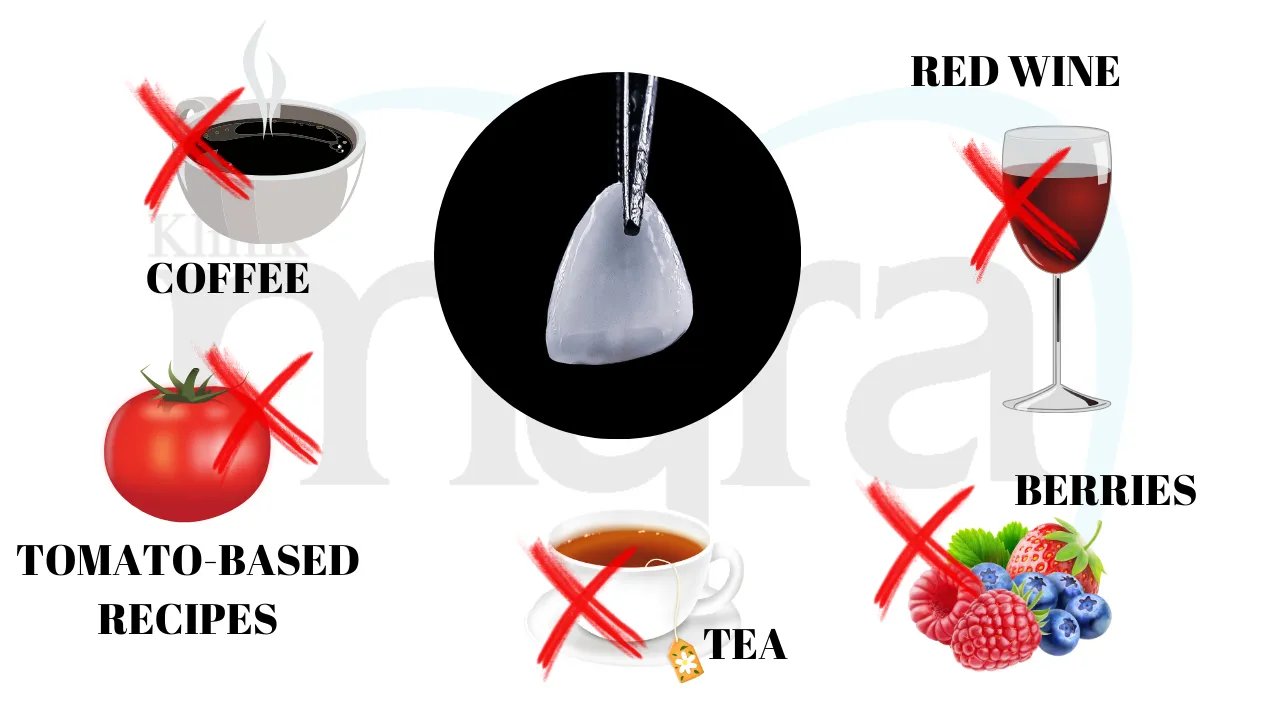
1. Coffee
Coffee is a common culprit when it comes to staining veneers due to its combination of colour pigments and tannins. The deep colour of coffee comes from compounds known as chromogens, which are responsible for the beverage's rich colour. Coffee contains tannins, organic substances found in plants that have astringent properties and cause pigments to stick to surfaces.
Pigmented compounds from coffee attach to the porous surface of veneers. Veneers are designed to resist stains, but over time, the porous nature of their microstructure allows some pigments to seep through. The porous nature of veneers, particularly if made from materials such as porcelain, provides an ideal surface for chromogens and tannins to adhere to, gradually leading to discolouration.
Regular consumption of coffee without proper rinsing or cleaning results in the accumulation of pigments on the veneer's surface. The pigments become embedded within the veneer material over time, altering its colour and diminishing its original brilliance. Moderation in coffee consumption and post-drinking rinsing help protect veneers from discolouration. Diligent oral hygiene practises and routine dental cleanings help mitigate the effects of coffee staining on veneers.
2. Tea
Tea contributes to staining veneers due to its content of colour pigments and tannins. The colour of tea is attributed to compounds called chromogens, which are present in the leaves and contribute to the beverage's distinct hue. Tannins, found in varying amounts in different types of tea, are organic substances with astringent properties that lead to the adhesion of pigments.
The pigmented compounds present in tea adhere to the surfaces of veneers when the beverage is consumed. The porous nature of veneers, especially if made of porous materials such as porcelain, allows these compounds to permeate the veneer's microstructure over time. The gradual accumulation of pigments within the veneer material causes the colour of the veneer to shift, resulting in visible staining.
Frequent consumption of tea without proper oral care leads to the buildup of pigments on the veneer's surface. Rinsing and cleaning after drinking tea helps prevent pigments from sticking to the veneer, as with other staining foods and drinks. Practising good oral hygiene, including regular brushing, flossing, and professional cleanings, aids in minimising the staining effects of tea on veneers.
3. Red wine
Red wine is a well-known contributor to veneer staining due to its vibrant colour and acidic nature. The intense colour of red wine comes from a combination of colour pigments and compounds found in the grape skins. Red wine contains acids that soften the surface of teeth and veneers, making them more susceptible to staining.
The pigmented substances in red wine stick to the porous surface of veneers after drinking it. Veneers are stain-resistant but their microstructure, which is made from porcelain, allows pigments to permeate. The acidic content of red wine contributes to the softening of the veneer's surface, making it more susceptible to the adhesion of colourants.
Frequent consumption of red wine without proper oral care results in the accumulation of pigments on the veneer's surface. The combination of both colour pigments and acids increases the likelihood of staining. Red wine stains veneers, so it is best to rinse the mouth out with water after drinking it and keep up with the oral hygiene routine. Professional dental cleanings help remove surface stains and preserve the appearance of veneers.
4. Berries
Berries are a potential cause of veneer staining due to their rich natural pigments. The vibrant colours of these fruits are attributed to compounds called anthocyanins, which adhere to dental surfaces, including veneers, and cause visible discolouration.
The pigmented compounds in berries adhere to the veneers' porous surface after consumption. Stains penetrate veneers over time due to their microstructure, especially if the veneer is made of porous materials such as porcelain.
The natural pigments in berries are potent colourants that have the potential to gradually alter the colour of veneers. Regular consumption of berries without thorough rinsing or cleaning afterwards leads to the accumulation of these pigments on the veneer's surface. Rinsing the mouth after eating berries and practising good oral hygiene help prevent staining. Taking preventative measures to care for the veneers reduces the staining that berries cause and keeps them looking great.
5. Tomato-based recipe
A tomato-based recipe refers to dishes, sauces, or recipes that prominently feature tomatoes as a primary ingredient. Examples include tomato sauces, ketchup, and tomato-based stews.
Tomato-based recipes contribute to the staining of veneers due to the intense colour pigments present in tomatoes and their potential to adhere to dental surfaces. Tomatoes contain compounds called lycopene and other carotenoids, which are responsible for their rich red colour.
The pigmented compounds in tomatoes, which are consumed in tomato-based recipes, adhere to the porous surface of veneers. Veneers are designed to resist staining, but their microstructure, especially if made of porcelain, allows pigments to permeate.
The concentrated colour of tomato-based recipes, combined with their potential to adhere to veneers, leads to gradual staining. Frequent consumption of tomato-based dishes without proper oral care results in the accumulation of pigments on the veneer's surface. Tomato-based dishes stain the teeth unless the person takes extra care to rinse their mouth and brush their teeth after eating them. Regular dental check-ups and cleanings aid in preserving the appearance of veneers by removing surface stains.
How to improve oral hygiene to prevent veneers from staining?
To prevent the veneers from staining, it's crucial to consistently practise excellent oral hygiene habits tailored to their unique care requirements. Begin by selecting a soft-bristled toothbrush, as it provides the necessary cleaning power while minimising the risk of damaging the delicate surface of the veneers. Pair it with a toothpaste that is explicitly veneer-friendly, avoiding abrasive formulations that compromise the integrity of the veneer material. Brush the teeth thoroughly, using gentle circular motions to clean the veneers.
Flossing must be an integral part of one’s daily routine, as it removes debris from the spaces between teeth and around their veneers, preventing the accumulation of plaque and potential staining agents. Enhance one’s routine by incorporating a veneer-safe mouthwash, which aids in maintaining fresh breath and contributes to the cleanliness of one’s oral health.
Mindful dietary choices play a pivotal role in preserving veneer health. Some foods and drinks, such as coffee and red wine, have the potential to leave stains. Consider sipping staining beverages through a straw to minimise direct contact with the veneers, helping to mitigate potential discolouration.
Hydration and the avoidance of smoking are dual-fold principles that bolster the vitality of veneers. Drinking enough water throughout the day fosters saliva production, which acts as a natural cleanser and aids in maintaining oral health. Quitting smoking, including e-cigarettes benefits one’s health and contributes to preventing the discolouration and damage that smoking imposes on veneers.
A night guard is recommended if a person is a chronic teeth grinder or clincher, especially during sleep. It’s a protective measure that safeguards the veneers and one’s natural teeth from potential damage, prolonging the life and vibrancy of dental work.
Regular dental check-ups are crucial, affording professional cleanings and thorough examinations of the veneers' condition. The dentist addresses any concerns, monitors the health of the person’s veneers, and guides the person in refining their oral care routine.
Consult a dentist for advice on how to best care for the veneers, taking into account one’s individual dental history and current needs. Maintaining good oral hygiene prolongs the life of the veneers and brightens one’s smile.
How to prevent veneers from staining?
To prevent veneers from staining, follow these 10 steps.
- Brush and Floss Regularly. Prioritise consistent brushing and flossing to eliminate food particles and plaque that accumulate on both natural teeth and veneers. Employ a soft-bristled toothbrush and fluoride toothpaste to ensure gentle care.
- Avoid Certain Foods and Drinks. Steer clear of foods and beverages that have staining potential, such as red wine, tea, coffee, and dark-coloured fruits and vegetables. Preserving the veneer’s shine requires protection from discolouring substances.
- Use a Straw. It is best to use a straw when drinking coffee or red wine to prevent spills. The simple step helps to divert the liquid away from both the teeth and veneers, decreasing the likelihood of staining.
- Rinse After Eating. It is important to quickly rinse the mouth with water after eating. The practise aids in dislodging any lingering food particles that lead to staining, reducing the risk of discolouration.
- Avoid Smoking. Smoking, including electronic cigarettes, leads to veneer staining. Abstaining from smoking benefits one’s health and contributes to maintaining the appearance of the veneers.
- Use a Whitening Toothpaste. Incorporate a whitening toothpaste formulated for veneers into one’s oral care routine. Excessively abrasive toothpaste ruins veneers, so be careful.
- Avoid Teeth Grinding. Teeth grinding, or bruxism is a common source of wear and tear on veneers. Wear a mouthguard while sleeping to safeguard the veneers and maintain their pristine appearance.
- Visit Your Dentist Regularly. Scheduled dental visits are vital for the ongoing health and beauty of the veneers. Regular check-ups help the dentist identify any signs of damage or staining, offering tailored advice to prevent deterioration.
- Use a Soft-Bristled Toothbrush. Selecting a soft-bristled toothbrush is crucial for safeguarding the veneers. Brushes with hard bristles are abrasive and cause harm to the veneer's surface.
- Use a Veneer-Friendly Mouthwash. Choose a mouthwash that’s designed for veneers, as it balances the need for effective oral hygiene with a formula gentle enough to preserve the veneer's appearance.
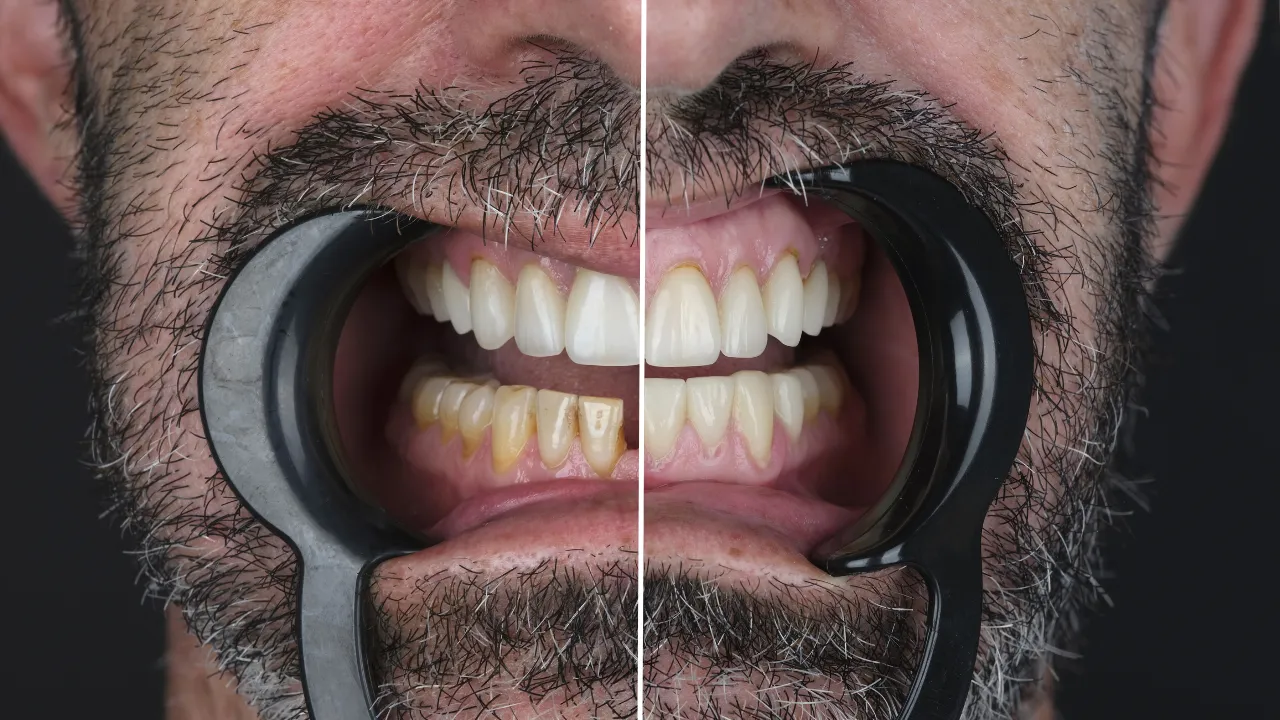
Are there risks in dental veneer staining?
Yes, there are risks associated with dental veneer staining. Dental veneer stains possess risks if left untreated, including discolouration, aesthetic concerns, an uneven smile, decreased confidence, long-term damage, tooth decay, and difficulty in the removal and replacement of veneers.
The stains on the veneers become more noticeable and prominent over time. A minor discolouration worsens over time, resulting in a mismatch between the veneers and the natural teeth. The primary purpose of veneers is to enhance the aesthetic appeal of a person’s smile. The appearance of the smile is compromised if stains are left untreated, reducing the person's confidence and satisfaction with their dental investment.
Stains on veneers create an uneven and inconsistent smile. Drawing attention away from the veneers and negatively impacting the harmony of one’s smile. Stained veneers lead to self-consciousness about one's smile's appearance. Affecting the person’s social interactions, confidence levels, and quality of life.
Prolonged exposure to staining agents hurts the veneer, making it more susceptible to cracks, chips, and other structural issues. Stains are indicative of compromised oral hygiene, which leads to an increased risk of dental problems. Plaque and tartar buildup result in tooth decay or even affect the health of the underlying natural teeth.
The longer stains are left untreated, the more they get embedded in the veneer material. Making stain removal harder and less effective. Requiring more drastic measures to restore the veneers to their original appearance. Veneers need to be replaced to achieve the desired aesthetics in severe cases of untreated stains. It involves additional time, expense, and potential discomfort. Addressing the risks of dental veneers staining promptly isn’t solely about upholding visual aesthetics. It is about safeguarding one’s dental health and well-being.
Can you whiten veneers?
No, you cannot whiten veneers. Veneers are made from materials such as porcelain or composite resin, which are stain-resistant and have a specific shade that is chosen to match the natural tooth colour. Traditional methods for whitening teeth do not work on veneers because their colour is built in and does not change over time as tooth enamel does. Professional cleaning restores the veneers' porcelain glaze. There are several fundamental reasons why veneers are difficult to whiten, including the veneer’s natural colour, material composition, placement, and preservation of appearance.
Veneers are meticulously crafted to achieve a specific colour that seamlessly blends with the person's existing teeth and enhances their smile. Veneers don’t absorb stains as real teeth's porous enamel does and maintain their original colour after fabrication. The natural colour stability renders them impervious to the chemical agents used in conventional teeth whitening methods.
Porcelain and composite resin are the two most common materials used for veneers because of their exceptional durability and stain resistance. The qualities make them resilient against the bleaching effects of teeth-whitening products, ensuring that the chosen veneer shade remains consistent over time.
The professional placement of veneers reinforces their unalterable colour. Veneers are custom-designed to fit precisely and securely onto the front surface of the teeth. Attempting to modify their colour post-placement necessitates the complete replacement of the veneers. A process that involves considerable expense and has the potential to compromise the underlying tooth structure.
Attempting to whiten veneers using traditional teeth whitening methods leads to uneven colouration, undermining the entire harmonious appearance of one’s smile. It underscores the importance of selecting the desired veneer shade in consultation with the dentist before the veneers are even crafted. The unique material composition, natural colour stability, professional placement, and preservation of appearance all collectively emphasise that veneers aren’t capable of being whitened after placement, highlighting the significance of thoughtful pre-placement shade selection for achieving lasting aesthetic results.
Are Dental Laminates more prone to staining compared to Dental Veneers?
No, dental laminates have a relatively better advantage than dental veneers. Dental Laminates and Dental Veneers are terms that are used interchangeably to refer to thin shells of material placed on the front surface of teeth to improve their appearance. The quality of the fabrication and the material used, rather than the precise terminology, determine how susceptible something is to staining.
Dental Laminates and Dental Veneers, used interchangeably to describe thin shells placed on teeth to enhance appearance, aren’t inherently more prone to staining than each other. The similarity arises from shared attributes, primarily stemming from material composition. Similar materials, such as porcelain or composite resin, are used to make both types because they resist external discolouration. The staining potential of both Dental Laminates and Dental Veneers is influenced by the quality of fabrication. Well-crafted laminates or veneers must boast a smooth, meticulously sealed surface that actively minimises the adherence of staining agents to the restoration material. The key to ensuring long-lasting resistance to discolouration is fabrication excellence.
The expertise of the dentist in the placement and bonding of these restorations is critical. A skilled approach guarantees a precise fit and an effective seal, reducing the likelihood of trapping staining substances between the restoration and the tooth. A proper fit minimises exposure to external staining agents. Regular maintenance, through conscientious oral hygiene practises such as consistent flossing, brushing, and attending dental check-ups, serves as a cornerstone in the prevention of staining for both Dental Laminates and Dental Veneers. Diligent care reinforces the stain-resistant attributes of the materials.
Lifestyle factors affect the staining susceptibility of both types of restorations. Routines such as smoking and the consumption of foods and drinks that stain. It's crucial to recognise the nuances in their material, preparation, and application when comparing "Dental Veneers vs Laminates". The factors underscore the significance of conscious lifestyle choices in maintaining the stain-resistant properties of Dental Laminates and Dental Veneers.





